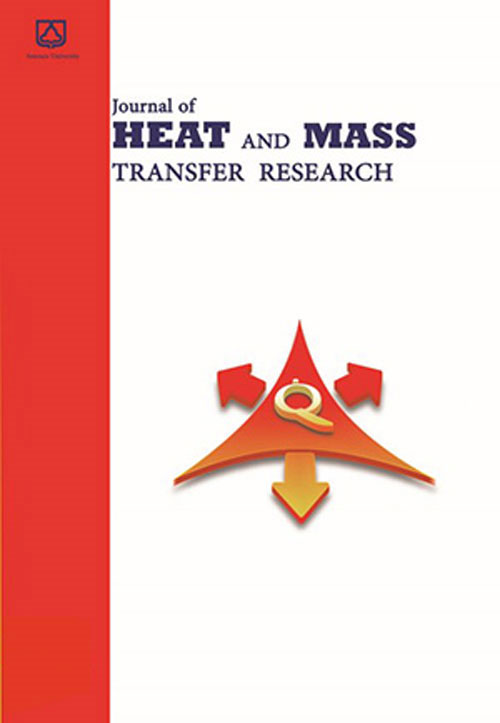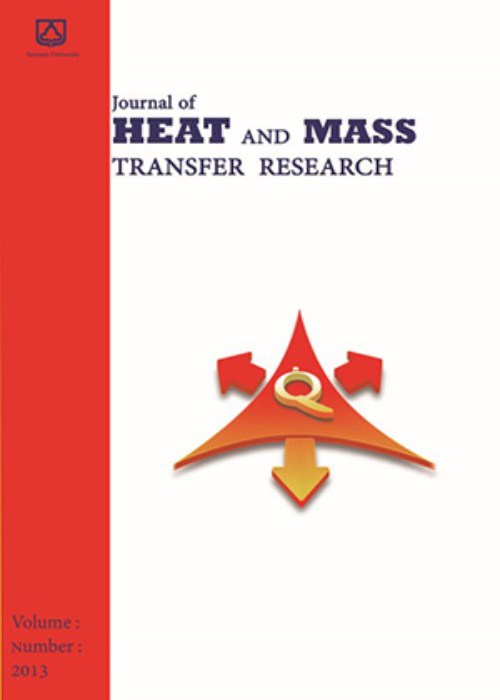فهرست مطالب

Journal of Heat and Mass Transfer Research
Volume:1 Issue: 1, Winter-Spring 2014
- تاریخ انتشار: 1394/06/20
- تعداد عناوین: 7
-
-
Page 1This study is concerned with the prediction of particles velocity in a dilute turbulent gas-solid boundary layer flow using a fully Eulerian two-fluid model. The closures required for equations describing the particulate phase are derived from the kinetic theory of granular flows. Gas phase turbulence is modeled by one-equation model and solid phase turbulence by MLH theory. Results of one-way and two-way coupled approaches are compared with the available experimental and numerical results. Results show that one-way coupled approach is more efficient for particulate velocity prediction in dilute flows. But, if the gas-phase flow characteristics are desired, the twoway coupled approach should be used. Effects of free stream velocity on the coupling are discussed.Keywords: Two, way coupled, Gas, particle flow, Kinetic theory, Turbulent boundary layer
-
Page 9The effect of a transverse magnetic field on the boundary layer flow and heat transfer of an isothermal stretching cylinder is analyzed. The governing partial differential equations for the magnetohydrodynamic, temperature, and concentration boundary layers are transformed into a set of ordinary differential equations using similarity transformations. The obtained ordinary differential equations are numerically solved for a range of non-dimensional parameters. Results show that the presence of a magnetic field would significantly affects the boundary layer profiles. An increase in magnetic parameter would decrease the reduced Nusselt and Sherwood numbers.Keywords: Nanofluid, Stretching cylinder, Magnetic field, Brownian motion, Thermophoresis
-
Page 17Rheological characteristics of Al2O3, CuO and TiO2 nano particles were investigated in oil as the base fluid at 1 and 2 wt.%. Constitutive relations for non-Newtonian fluid were discussed based on the power-law model. Measured viscosities of each nanofluid were used to evaluate the power-law and consistency index. Results indicated that the nanofluid viscosity decreased by increasing the concentration. Oil showed shear thickening behavior while nanofluids showed shear thinning behavior. An increase in nano-particle concentration caused a decrease in the power-law index beside an increase in the consistency index. Moreover, the present study showed that the effective viscosity of fluids would be decreased by nanoparticle addition at some wt.% and some shear rates. Furthermore, results showed that the classic models for nanofluid viscosity couldnt predict their real values of nano fluid viscosity, as the measured values are less than the predicted ones.Keywords: Nanofluids, Viscosity, Rheological characteristics, Power, law index, Consistency index
-
Page 25In this paper, second law analysis for calculations of the entropy generation due to the flow and heat transfer of water-Al2O3 and ethylene glycol-Al2O3 nanofluids inside annuli is presented. The physical properties of the nanofluids are calculated using empirical correlations. Constant heat fluxes at inner surface of the annuli are considered and fully developed condition for fluid flow and heat transfer is assumed. The control volume approach is selected for calculation of the entropy generation. Total entropy generation for different values of the nanoparticles volume fractions at different geometrical ratios is obtained and compared with those of the base fluid. Also, the geometrical ratios at which the minimum entropy generation is achieved are presented. The results show that when the ratio of the annuli length to its hydraulic diameter (L/Dh) exceeds some critical values, adding of the nanoparticles is not efficient. For each value of the nanoparticles concentration, there is a length ratio (L/Dh) at which the entropy generation is minimized.Keywords: Second law of thermodynamics, Entropy generation, Nanofluids, Heat transfer, Annuli, Laminar flow
-
Page 35In this study, mixed convection heat transfer and local and global entropy generation in a
ventilated square cavity have been investigated numerically. The natural convection effect is achieved by a constant heat flux imposed at the bottom wall and cooled by injecting a cold follow. In order to investigate the effect of port location, four different placement configurations of the inlet and outlet ports are studied. In each case, external flow enters into the cavity through an inlet port in the left side of the cavity and exits from the opposite side. The other boundaries are assumed adiabatic. The cavity is subjected to laminar flow of water. The investigation has been carried out for the Re=1000, and the Richardson number with the range of 0.0001(Global Entropy Generation), Heat Transfer Irreversibility (HTI) and Fluid Friction Irreversibility (FFI) are calculated and compared. Then, the optimum inlet/outlet configuration has been selected based on the minimum GEG and the maximum heat transfer.Keywords: Vented square cavity, Entropy generation, Heat transfer, Irreversibility, Fluid friction irreversibility -
Page 47Experimental study of effective thermal conductivity of ZnO/EG nanofluid is presented in this research. The nanofluid was prepared by dispersing Zno nanoparticles in ethylene glycol using a sonicator and adding surfactant. Ethylene glycol based nanofluid containing ZnO nanoparticle with a nominal diameter of 18 nm at different solid volume fractions (very low to high) at various temperatures was examined for the investigation. The thermal conductivity of nanofluids is experimentally measured with THW method and it is found that the thermal conductivity of nanofluids increase with the nanoparticle volume concentration and temperature. Also, based on experimental values of thermal conductivity of nanofluid, three experimental models are proposed to predict thermal conductivity of nanofluids. The proposed models show reasonably excellent agreement with our experimental results.Keywords: Thermal conductivity, Heat transfer, Nanofluid, Thermophysical properties
-
Boundary layer flow beneath a uniform free stream permeable continuous moving surface in a nanofluidPage 55The main purpose of this paper is to introduce a boundary layer analysis for the fluid flow and heat transfer characteristics of an incompressible nanofluid flowing over a permeable isothermal surface moving continuously. The resulting system of non-linear ordinary differential equations is solved numerically using the fifthorder RungeKutta method with shooting techniques using Matlab and Maple softwares. Numerical results are obtained for the velocity, temperature, and concentration distributions, as well as the friction factor, local Nusselt number, and local Sherwood number for several values of the parameters, namely the velocity ratio parameter, suction/injection parameter, and nanofluid parameters. The obtained results are presented graphically in tabular forms and the physical aspects of the problem are discussed.Keywords: Suction, injection, Moving surface, Nanofluid, Runge, Kutta method, Shooting techniques, Dual solutions


